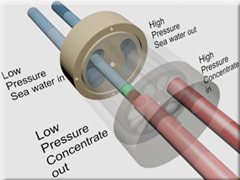Energy Recovery Inc. has developed an ingenious pump that greatly reduces the energy needed to extract salt from seawater, a small but vital innovation that could help transform ocean water into something fit to drink.
The PX Pressure Exchanger developed by Energy Recovery Inc. recently propelled the 68-person company into an initial public offering in a market that has been risk averse because of the nation's economic uncertainty.
Since Energy Recovery went public in July at $8.50 per share, raising $68 million, its shares have risen in a down market - closing Friday at $11.34 - based on sales and expectations that demand for desalination plants will continue to rise as coast-hugging populations turn to the oceans. As the company told potential investors in its prospectus, "growth in the market for new total desalination capacity should increase by approximately 13 percent per year from 2005 to 2015."
Revenue has grown from $4 million in 2003 to $35.4 million in 2007.
Energy Recovery Chief Technology Officer Richard Stover said the energy-saving pump is a tiny but pivotal component in what are huge desalination plants.
State-of-the-art desalination plants suck in seawater and then use electricity-driven pumps to put it under pressure. This salty stream is then slammed against filters designed to let the fresh water bleed through while sequestering the high-pressure brine - a process called reverse osmosis.
"It takes a lot of pressure to get the pure water to go away from the salt, and it takes a lot of energy to pressurize the water," Stover said.
That's where Energy Recovery comes into play. The company designed its pump to capture the pressure trapped in that left-behind brine and recycle its energy into repressurizing the next batch of virgin seawater destined to be slammed against those reverse-osmotic filters.
All that sucking and pressurizing consumes gobs of electricity, and power expenses account for one-third to one-half of the total cost of seawater desalination, according to the Pacific Institute, a nonprofit think tank in Oakland that has written a 90-page report on the topic.
Heather Cooley, an environmental biologist and desalination expert at the institute who has toured Energy Recovery's San Leandro plant, said the company's energy recycling pump looks like a winner because it helps reduce a key cost.
So far, Wall Street seems to feel the same, as shares in this new company remain strong in a weak market. In its prospectus, Energy Recovery tells potential investors that most of its sales have come from parched foreign locales like Western Australia and the oil-rich, water-poor Middle East.
But Cooley says 19 desalination plants are on the drawing boards in California, including one in Carlsbad (San Diego County) that comes up for a crucial vote before the California Coastal Commission on Wednesday.
That plant, being promoted by Poseidon Resources Corp. of Stamford, Conn., is testing Energy Recovery's pump and thus could provide a new client for the firm - and pave the way for similar plants further back in the permit process.
But Amy Zander, a professor of environmental engineering at Clarkson University in New York and chairwoman of a recent National Research Council report on saltwater desalination, said tapping the coast for drinking water is likely to be as tough a choice for California as the parallel issue of offshore drilling for oil.
"It's not a bad analogy, because perceptions are not always based on truth in either case," said Zander, who says saltwater desalination could work for some communities, but urges more study of the environmental consequences and alternatives such as purifying wastewater.
For the record, Energy Recovery isn't betting that California will open the floodgates for desalination. Its prospectus tells investors, "We expect sales outside the United States to remain a significant portion of our revenue for the foreseeable future."

